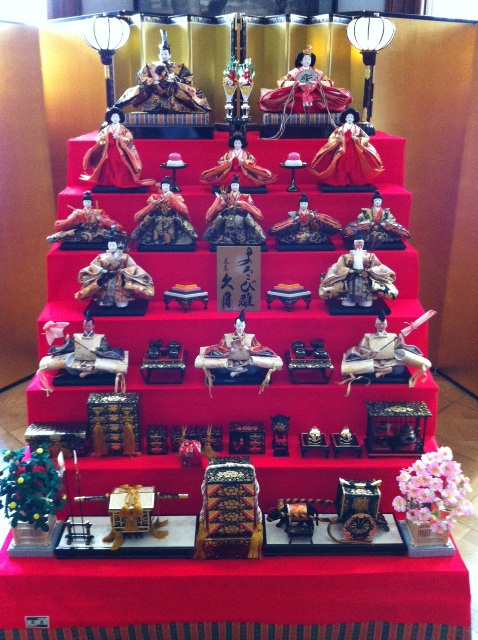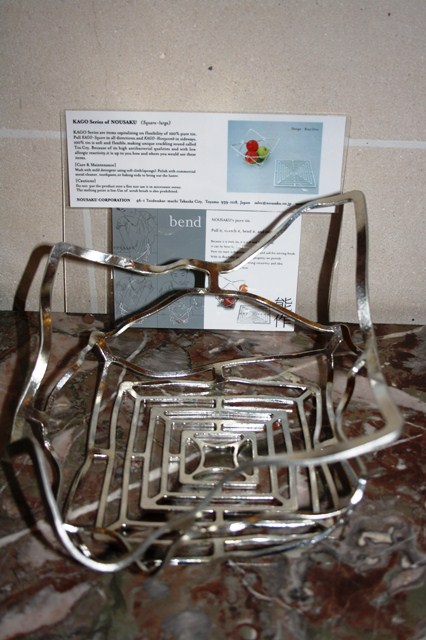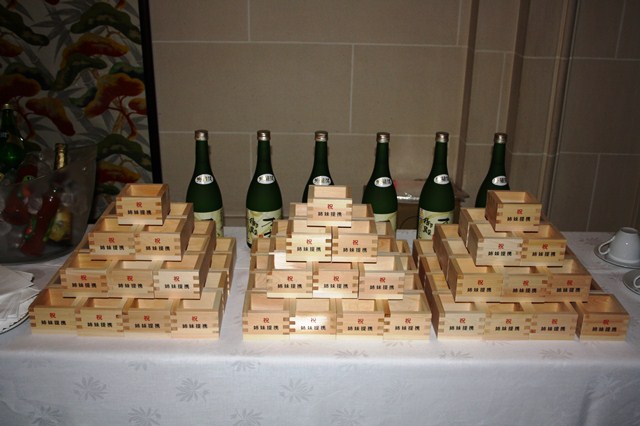
The Spirit of Hospitality (O-MO-TE-NA-SHI) (No.9)
16th February 2015
This time I would like to talk about a ‘softer’ topic, namely ‘Soft Power’.
It is a bit abrupt but, one of my important tasks is to invite and receive people at my residence. I always bear in mind that the residence of the Ambassador of Japan should be a house of "O-MO-TE-NA-SHI" (hospitality / entertainment) which is representative of Japan. 
First of all I would like the guests who visit to experience Japan even though they are in Belgium. Items which represent the seasons are important. Now, although a bit early, we have the hina-ningyo (traditional Japanese dolls). Although there are limitations due to the use of Western flowers, Ikebana flower arrangements matching the seasons are decorating the reception room and dinner table. By the way, this has become my wife’s job here.
Furthermore, casually decorating the residence with small objects that make you feel the Japanese ‘craftsmanship’ is also a clever method. For example, I use items from a company located in Hokuriku, which is famous since long ago for its metal casting. The objects are made from the metal tin, but the extraordinary objects can be manipulated into many shapes, sometimes they can take the shape of a basket, used for bread or fruit and other times they serve as a case for decorating wine. When guests arrive, they sign the guest book at the entrance, and next to it there is such an object so I show them in a casual way how it can change shape. This really surprises the guests. In Belgium you can have a look at these objects on the homepage and you can buy them now in several European cities (those who are interested may send an inquiry by e-mail to the embassy’s info mail address).
Of course, the most important goal of inviting guests is to have a nice conversation, to get acquainted, to build human relations in order to make work go smoothly and in the process obtaining useful information for Japan. For the guest it’s vice versa. For that reason it is also important to offer nice food. If the ambassador’s residence has a reputation of being a place where you can have delicious food, that in itself can be a strong power.
A Japanese chef specialized in French cuisine is cooking at the residence. In Brussels, which is famous for having a lot of nice French cuisine restaurants, it is necessary to have someone who can provide the flavor of the French cuisine. At the same time, the chef also cleverly adds some Japanese accents in the ingredients and seasoning. Sometimes, guests are served Japanese cuisine prepared with Belgian ingredients. Surely, if the guests can feel as if the food was made with them in mind it is the best I think.
Well then, when we speak of food we speak of drinks. Of course, when talking about French cuisine, it is wine; various wines that match the food have been developed through history, it is hard to compete with that. However, recently, in Belgium as well, interest in Japanese cuisine has grown and as a result the interest in Japanese sake is slowly on the rise as well. Even in Belgium one can buy several types of Japanese sake, although compared to Japan, the price is considerably high.
Furthermore, although French cuisine is served here in the residence, we try to serve Japanese sake as much as possible. By the way, in order to promote Japanese products, we import the Japanese sake directly from breweries in Japan at the domestic price.
In short, there are nowadays various kinds of Japanese sake.
• At the beginning of the meal, sparkling sake is served. Belgians like to have champagne but it is relatively unknown that there are also delightful sparkling types of sake. Here, in particular, I serve a slightly cloudy sparkling sake from the Tohoku region, an area that was struck by the Great Japan Earthquake. This sake has also been used to celebrate victory at the F1 races instead of champagne.
•Next is sake which can be drunk during the meal. It goes without saying that Japanese sake goes well with Japanese food, but it also pairs well with French cuisine with Japanese accents. Of course, Ginjo sake is wonderful but sometimes Honjozo is preferred because its delicate flavor doesn’t interfere with the food. At the residence we alternate between brands of Honjozo and Junmai sake from my home prefecture Hiroshima, which have recently received a lot of awards in competitions. Sometimes we serve both types so guests can compare.
• Finally, there is Kijoshu, served along with desserts. Normal sake is made from water, but Kijoshu is made by using sake itself as a base, giving it a sherry-like deep color and a really sweet aroma. Serving it with ice cream is very popular. At the residence we also use award winning Kijoshu from Hiroshima prefecture.
Not stopping at sake, but promoting also other Japanese products is one of our important tasks. Finally, I would also like to mention the great effort done by JETRO, for helping to supply real Japanese Wagyu beef for the Belgian market. When sometimes serving this Wagyu beef to an important guest, it really fills the guest with joy. Soon after, the question “where can I buy it?” comes up. If all over the world this kind of effort can be achieved, it would be great for the promotion of Japanese products. People of Belgium, please, enjoy Japanese sake and Japanese products!
|

